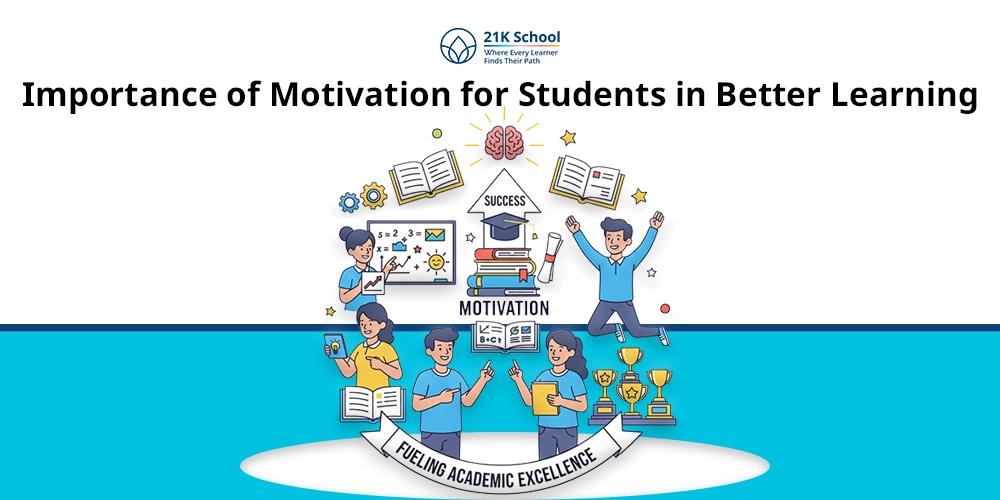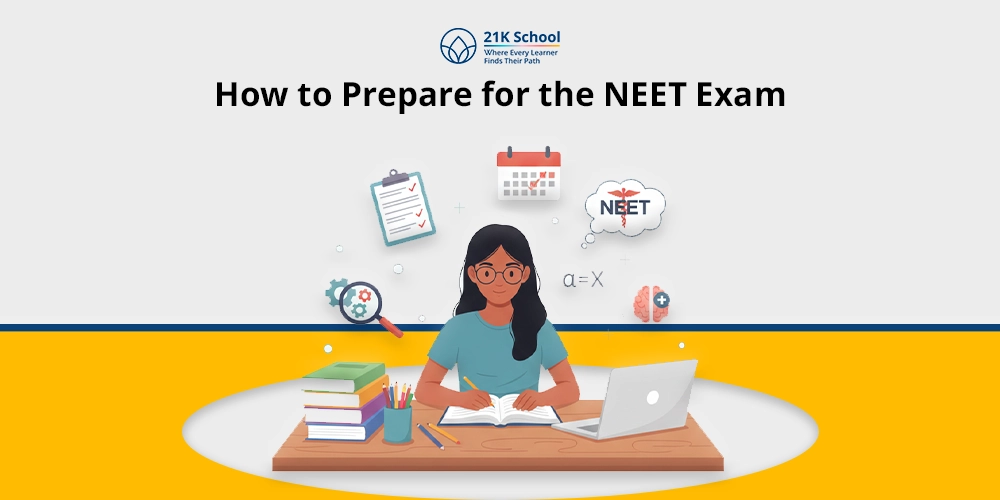
Everything nowadays revolves around our children’s education. And when it comes to the modern classroom, technology has more to do with it than anything else.
As we discuss classrooms, education, and digital advancement, it is important to understand the role of technology in maintaining the flow of communication in education.
In simpler words, they are known as digital classrooms, and it is believed that digital classrooms are the insight into the future of education, promoting inclusivity, personalised learning and even skill-based learning all in the comfort of home.
And, one such thing is ICT, Information and Communication Technology
Table of Contents
What is ICT?
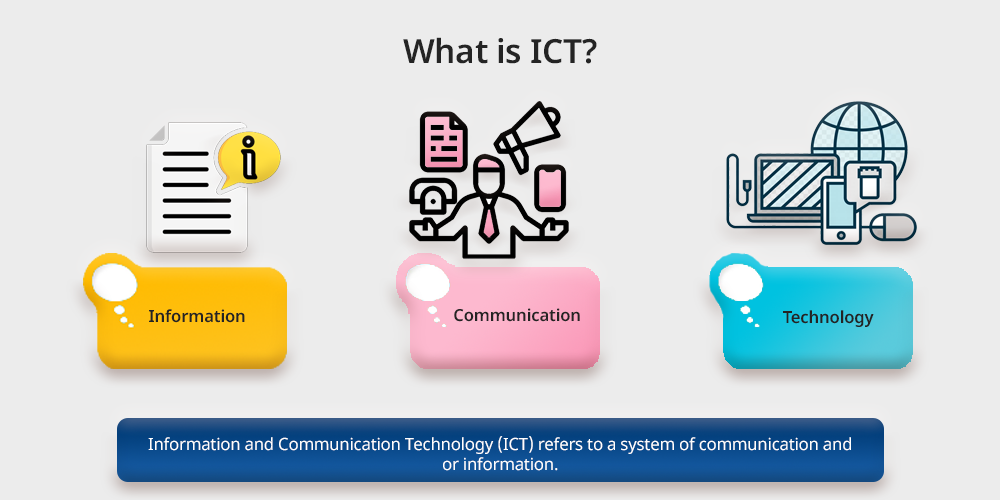
Information and Communication Technology (ICT) refers to a system of communication and information within the educational context, dealing with the provision of access to information through telecommunications. It essentially involves technology used for communication.
It’s not difficult to understand, from a layman’s perspective, that it covers almost all aspects of gadgets and their uses — from computers and the internet to radios and televisions, and even mobile phones.
Essentially, anything digitally driven and involved in the process of imparting education falls under ICT. ICT in education is an amazing concept.
Similarly, in the field of education, the use of ICT is a turning point that transforms conventional teaching methods into educative, communicative, and shareable forms of teaching, making them accessible and transferable.
Besides this, ict in education holds importance in various aspects.
What are the Key Advantages of ICT in Education?
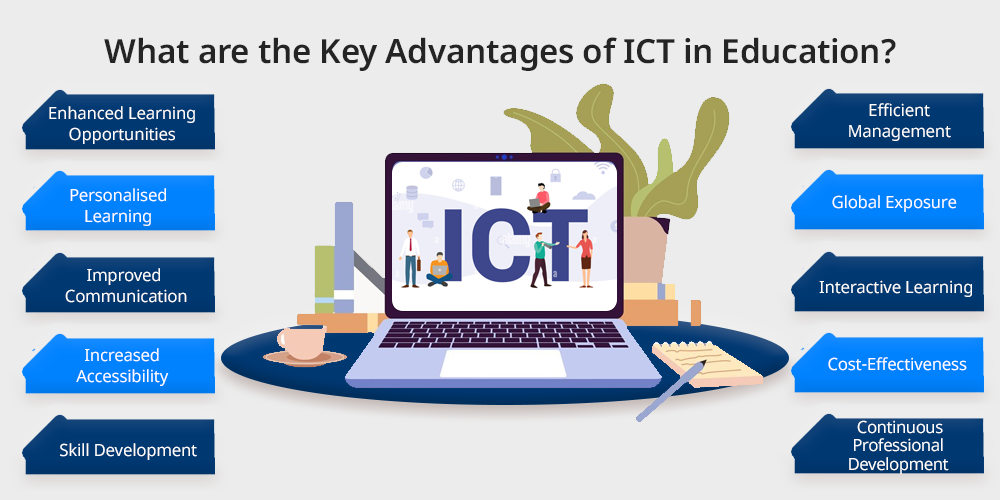
Technology itself is highly advantageous, especially when integrated to create a pathway for communication and the flow of information in the educational sector.
And with these advantages it is easy to conclude that sometimes, the internet is beneficial to students; only when used wisely, efficiently, effectively and under proper guidance.
ICT offers several benefits to the method of integrating technology into modern-day education, potentially resulting in transformative outcomes.
The integration of ICT in education brings numerous advantages to students, reshaping their learning experience, while also significantly benefiting teachers and educational institutions. It’s truly an all-rounder.
“Technology will never replace great teachers, but technology in the hands of great teachers is transformational.”
It provides us with countless opportunities to explore life beyond the classroom, with major advantages including:
1. Enhanced Learning Opportunities
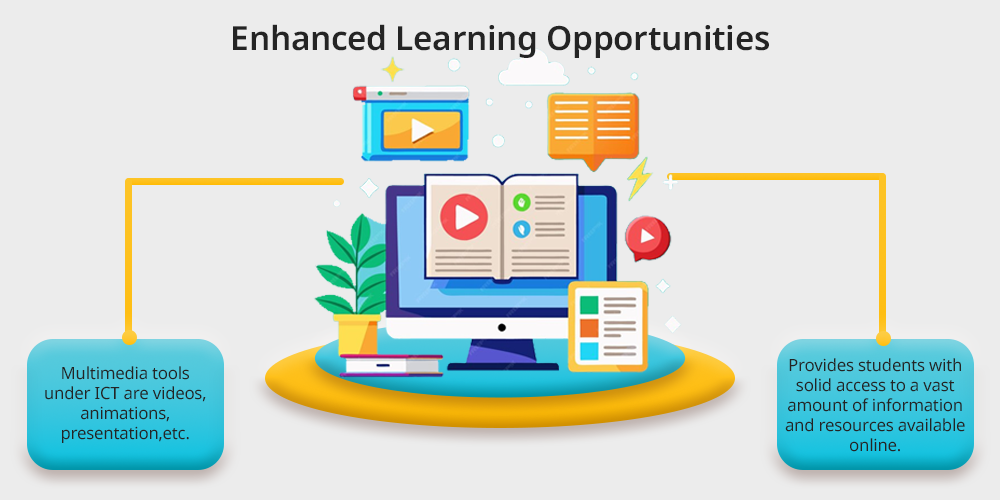
It’s never about the teacher, when it comes to study rather it’s mainly and mostly about the methodologies used by the teacher.
ICT tools are a modern twist to the pre-existing teaching methodologies, they provide students with solid access to a vast amount of information and resources available online.
The availability of resources beyond classrooms, enables students to explore various subjects and topics in-depth.
Most used Multimedia tools under ICT are videos, animations, presentations and interactive modules that tend to make learning more fun, engaging and easier to comprehend for learners.
2. Personalised Learning
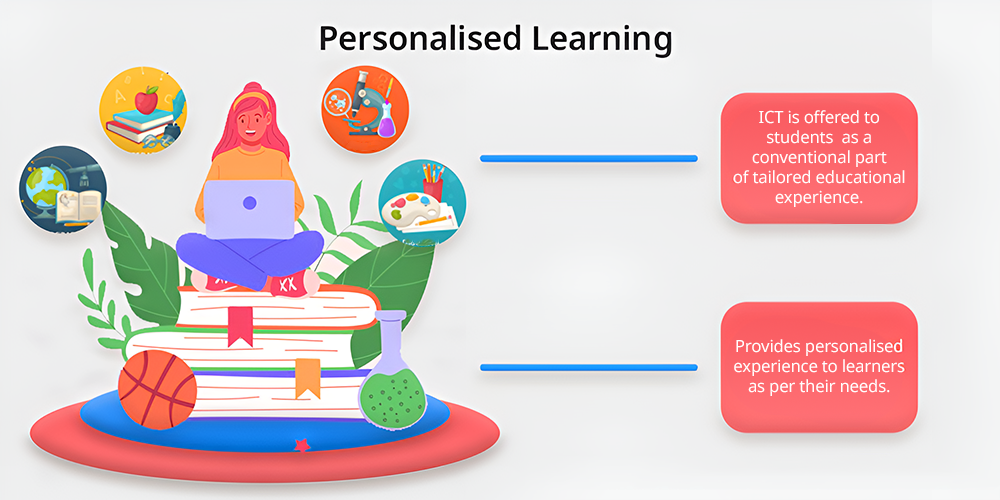
Learning opportunities in the modern-day scenario are too personalised for students as per their expectations and needs.
ICT is integrated into students’ educational experience as a conventional tool, catering to individual learning styles and paces, as is commonly discussed for students with special needs.
In simple terms, a key aspect of this educational structure lies in technological advancement, which provides a personalized experience for learners based on their needs, commonly referred to as personalised learning.
“The internet is becoming the town square for the global village of tomorrow.”
Everyone has access to this digital world and has full right to filter out the content they wish to look for, thus making personalisation easier.
3. Improved Communication
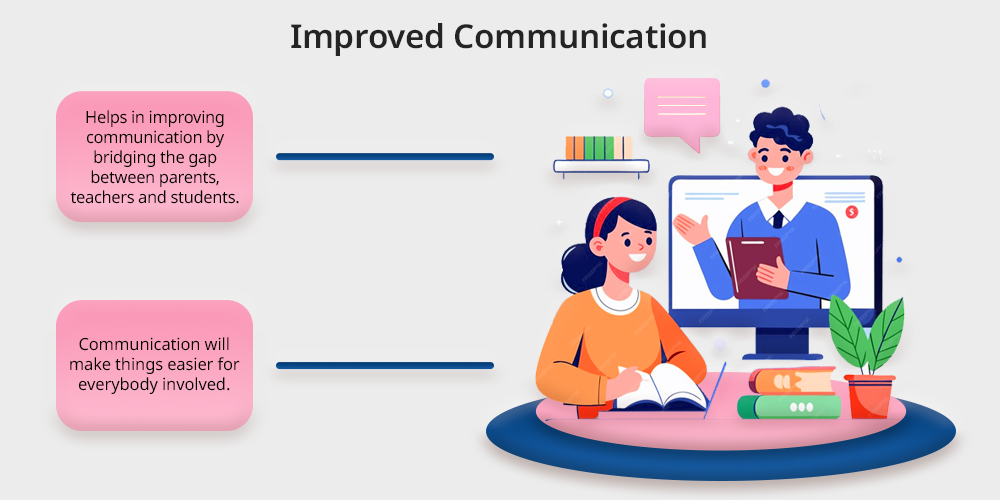
Just as the name suggests, ICT stands for information and communication technology.
The technology there, helps in improving communication by bridging the gap between parents, teachers and students through tools like email, discussion forums, and virtual classrooms.
Communication will make things easier for everybody involved, making it a transparent business, building trust.
It basically helps in collaboration, the collaboration that ensures consistent support and open channel communication, even beyond school hours.
4. Increased Accessibility
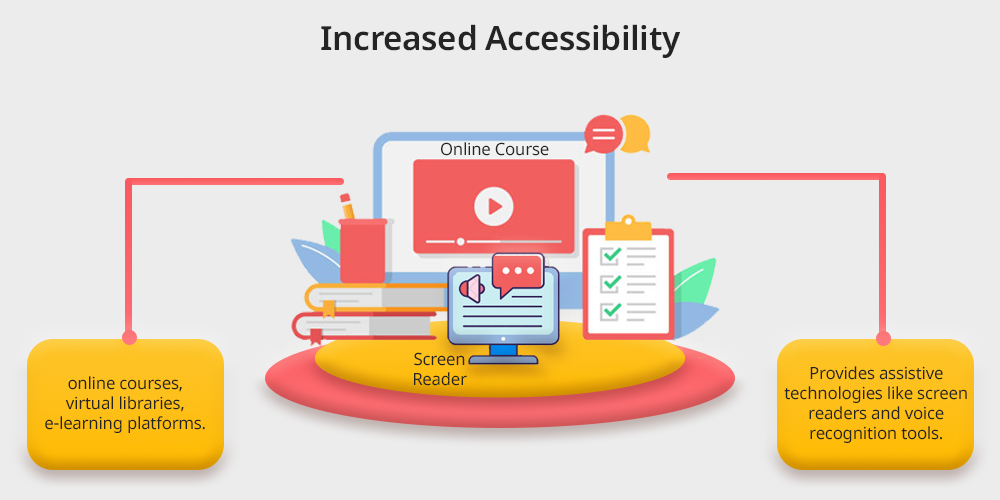
For students in remote or underserved areas, consider what helps them stay informed and educated in today’s world. Clearly, it is technology that makes education accessible to everyone.
ICT facilitates access to quality education through online courses, virtual libraries, e-learning platforms, and various other resources that contribute to academic success and enrichment.
As mentioned, ict in education also carry importance for students with special needs by providing assistive technologies, such as screen readers and voice recognition tools.
5. Skill Development
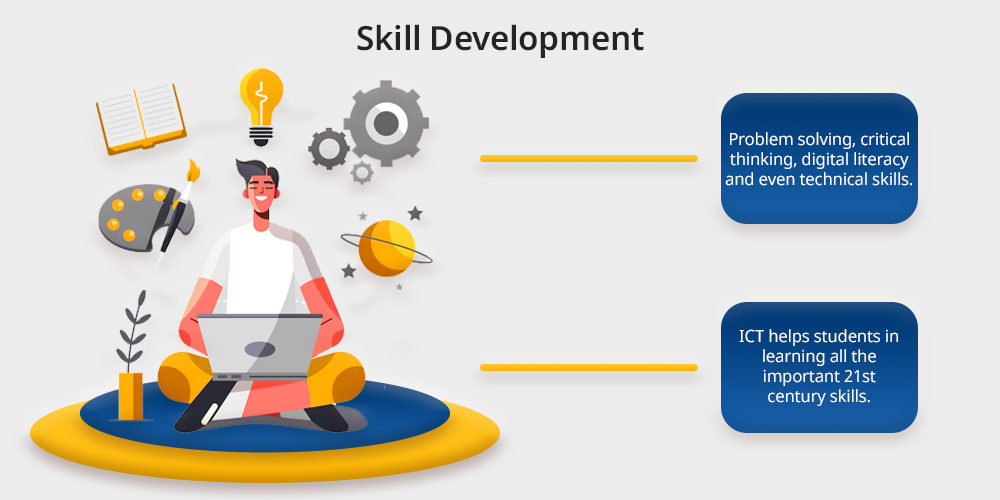
Technology truly brings miracles to people’s lives. With the introduction of ICT, learning essential skills has become easier—skills such as problem-solving, critical thinking, digital literacy, and even technical skills.
ICT aids students in acquiring vital 21st-century skills that are crucial for success academically, personally, and professionally.
6. Efficient Management
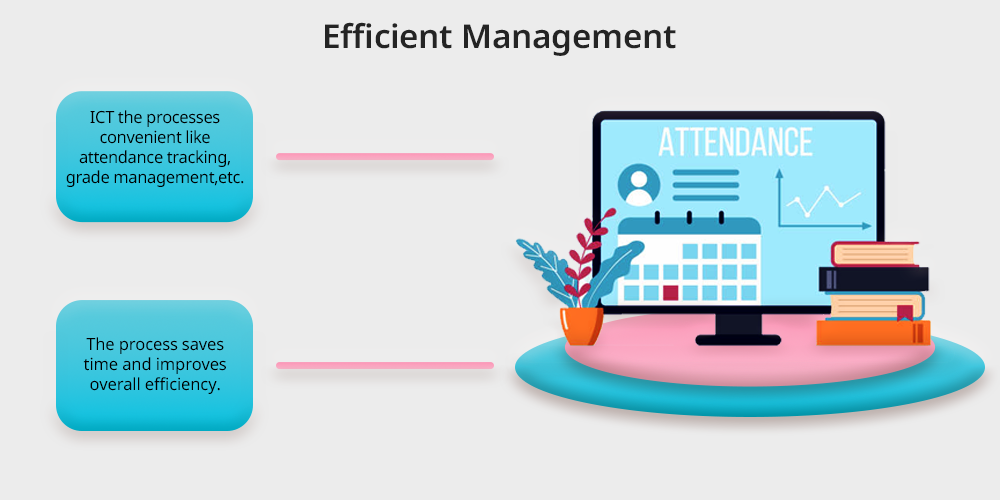
The structural education and traditional method of teaching had a lot of documentation to be done manually.
With time ICT makes administrative processes convenient like attendance tracking, grade management, and making an accessible pathway for Communication skills.
The process saves time and improves overall efficiency for all parties involved: institutions, parents, students and teachers.
7. Global Exposure
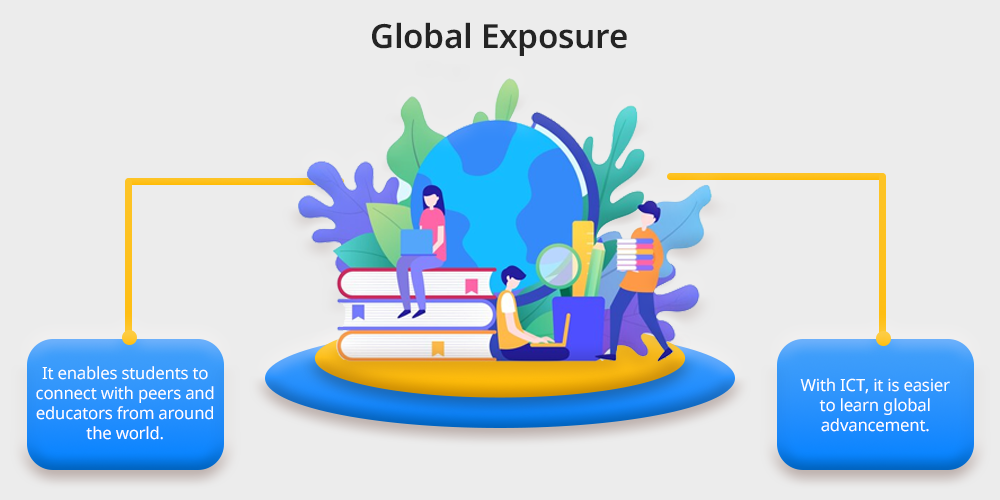
With ICT, it is easier to learn global advancement as it contributes to skills that ultimately make people well-equipped with skills to grow in their respective fields wherever required.
It enables students to connect with peers and educators from around the world making education more accessible across all demographics.
“The function of education is to teach one to think intensively and to think critically.”
With such global exposure, making people aware of cultural identity and exchanging cultural knowledge is easier, and so is promoting global awareness of the situation and circumstances.
8. Interactive Learning

With ICT, the classrooms of today are shaping the innovators, thinkers, and leaders of tomorrow.
ICT, being one of the most advanced methods of teaching, comes with cutting-edge, technology-driven tools like smartboards, educational apps, and online quizzes.
The traditional world of chalk and blackboards has now been enhanced with tools like smartboards, tablets, and extensive virtual libraries.
With these tools, learning becomes interactive and enjoyable, keeping students motivated and engaged. In today’s world, it is crucial to keep students engaged in classroom to promote their learning and maintain a steady flow of study.
9. Cost-Effectiveness
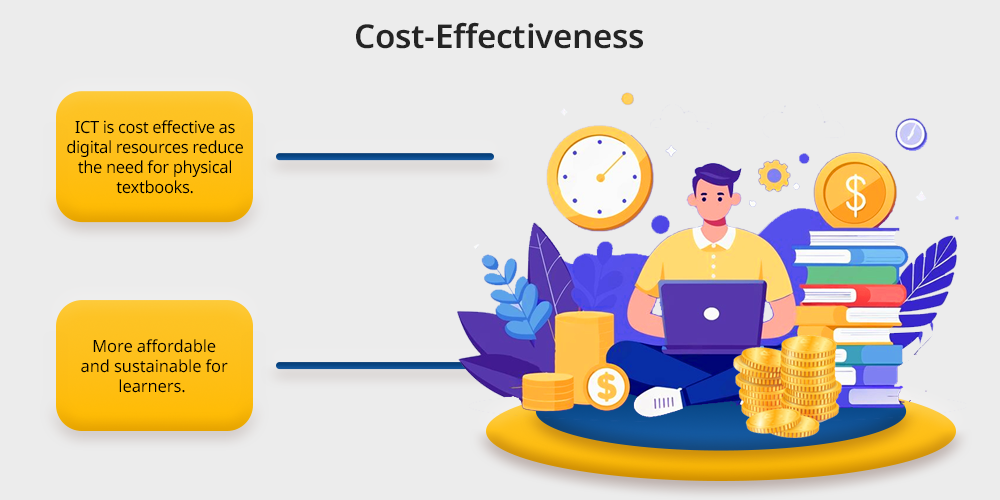
ICT is obviously cost-effective as digital resources reduce the need for physical textbooks and materials, making education more sustainable and affordable for learners.
There are some institutions that provide material over and ahead of their needs to provide students with more opportunities to be connected with their education and academic advancements after their schooling hours.
However, relying on alternatives to traditional resources can be costly upfront. But it’s more of a one-time investment for a lifelong commitment. So, it’s worth it.
10. Continuous Professional Development
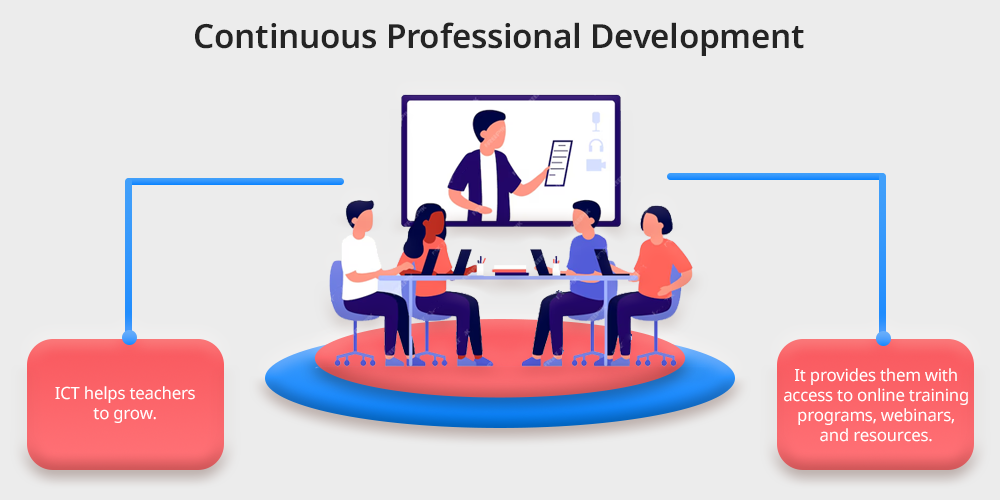
ICT is not just a protocol; it gradually becomes a lifestyle. For teachers, it represents a commitment to growth, providing access to online training programs, webinars, and resources that help them stay updated with the latest teaching methodologies and technologies.
It’s a win-win situation for everyone involved if used wisely and efficiently.
Like everything else in life, technology comes with its pros and cons. However, it is essential to analyze the the advantages and disadvantages of technology particularly before integrating it into any significant part of life.
Disadvantages of ICT in Education
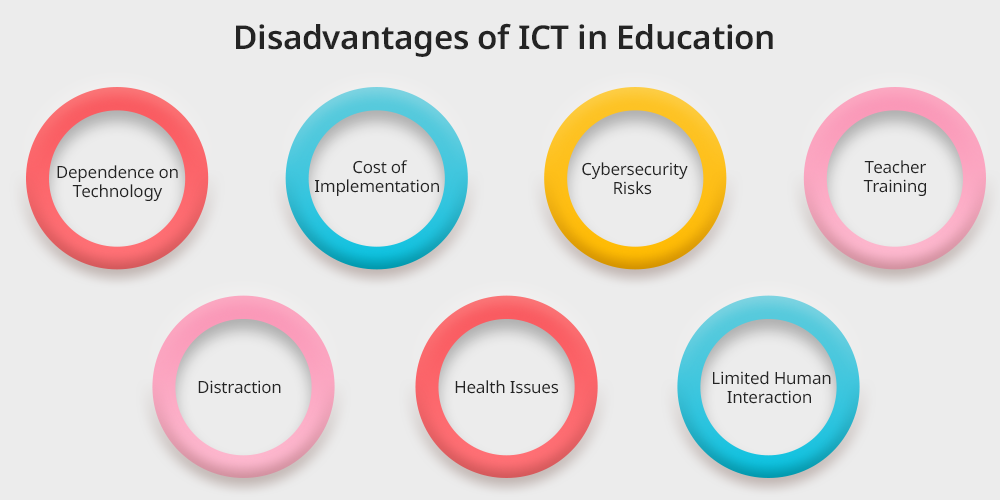
As discussed above ICT brings numerous benefits to learners as well as teachers, but like everything else in the world it also comes with its own demerits .
The most widely affecting drawbacks include
1. Digital Divide
The digital divide is a situation that cannot be ignored, especially in a country like India. Promoting equality becomes challenging, given the disparities in demographics and population.
In a situation like the digital divide, unequal access to technology creates disparities among students, leading to inequality and undermining the integrity of education.
2. Dependence on Technology
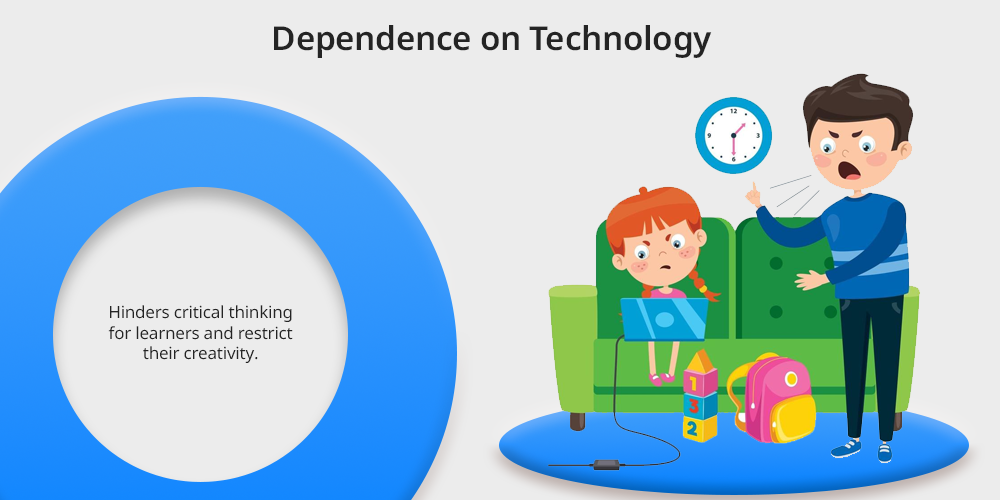
The concept of ICT revolves around technology, which, if over-relied upon, may hinder critical thinking and restrict creativity.
With everyday technological advancements, everything is now just a fingertip away, and screens often solve every problem that may arise.
2. Cost of Implementation
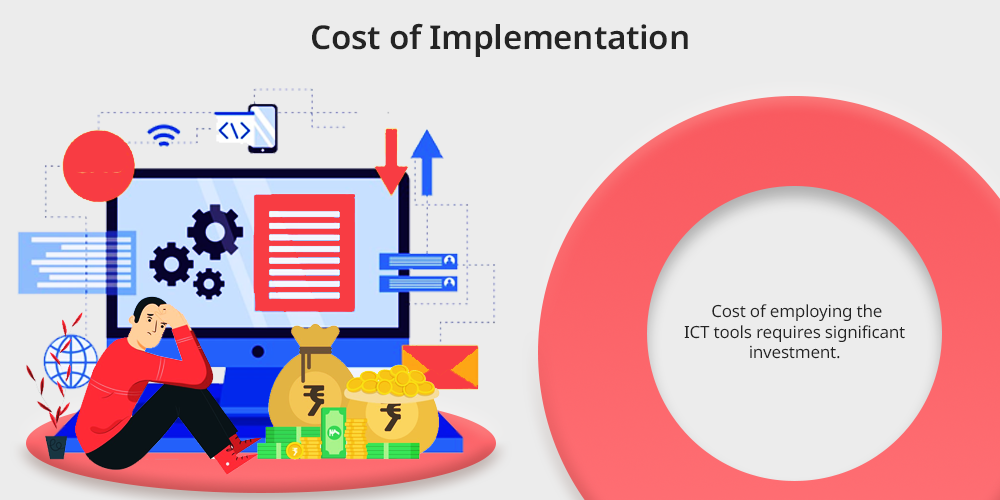
As mentioned, the cost of implementing ICT tools requires a significant investment.
While it may seem like a one-time expense, it is not something that everyone can afford, especially initially.
3. Cybersecurity Risks
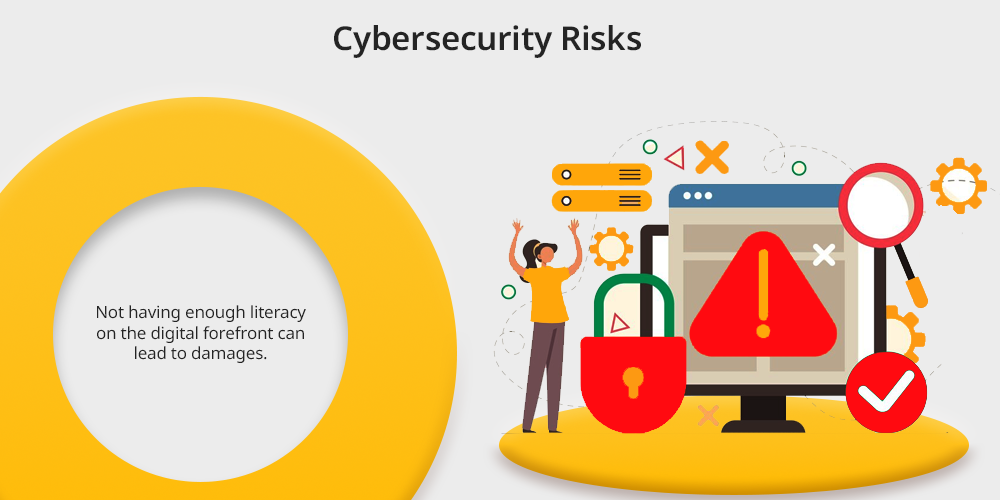
Considering the situation that exists in the digital world with breech, frauds and other threats to privacy and safety, not having enough literacy on the digital forefront can lead to damages that can not be handled until experts are involved;
4. Teacher Training
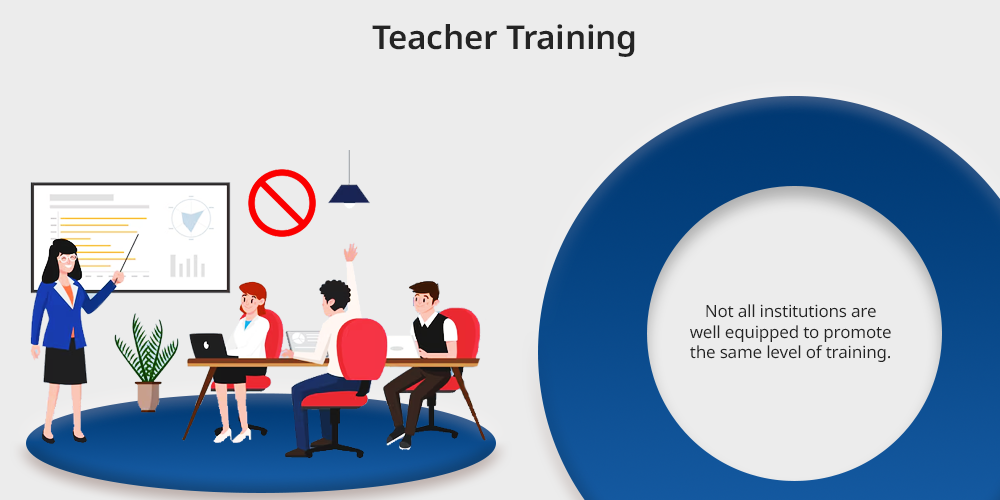
Challenges are for effective integration of the ICT, not all institutions are well-equipped to provide the same level of training, and this can hinder inclusivity.
5. Distraction
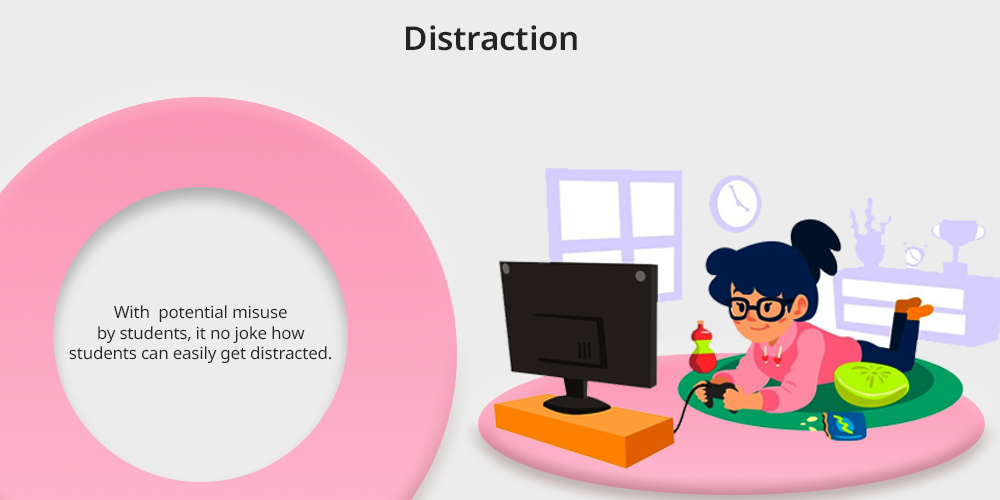
With the potential for misuse by students, it is no joke how easily they can get distracted. In the worst-case scenarios, the consequences can be alarming, and none of us want to witness them.
6. Health Issues
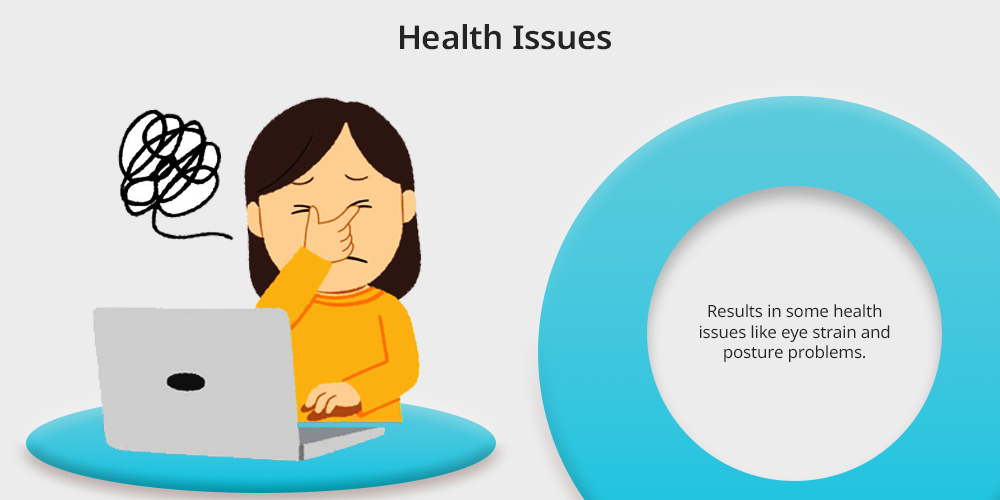
Prolonged screen time and continuous use of digital resources may lead to health issues, such as eye strain and posture problems, for both students and teachers. Health cannot be compromised for anything.
7. Limited Human Interaction
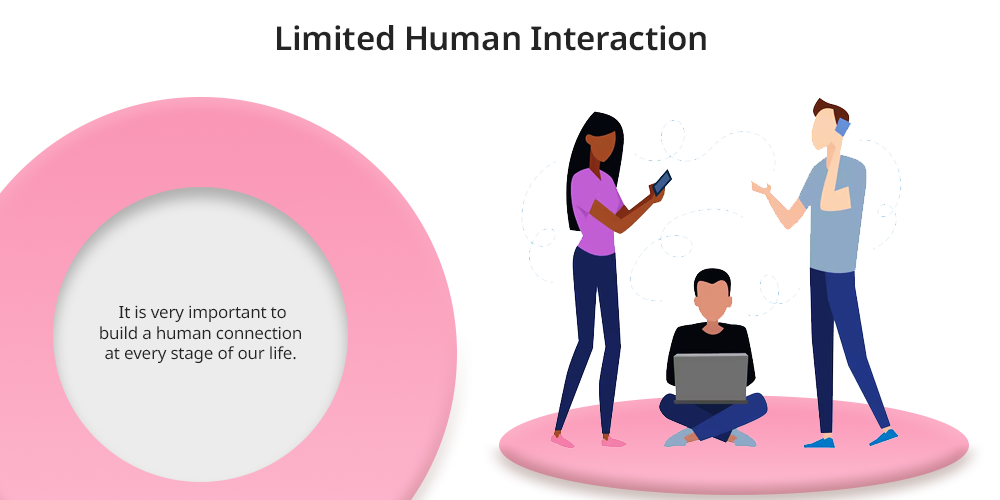
“Technology can open doors, expand minds, and bring the world closer, but it can never replace the warmth of human connection.“
While ICT can be a powerful tool, it may not entirely eliminate the need for traditional methods that are still incorporated into the system.
But it can Impact social and emotional development of a child, because after all humans can never be replaced in our life as we exist, it is very important to build a human connection at every stage of our life to grow and become a better individual with time.
Advantages of ICT in Education
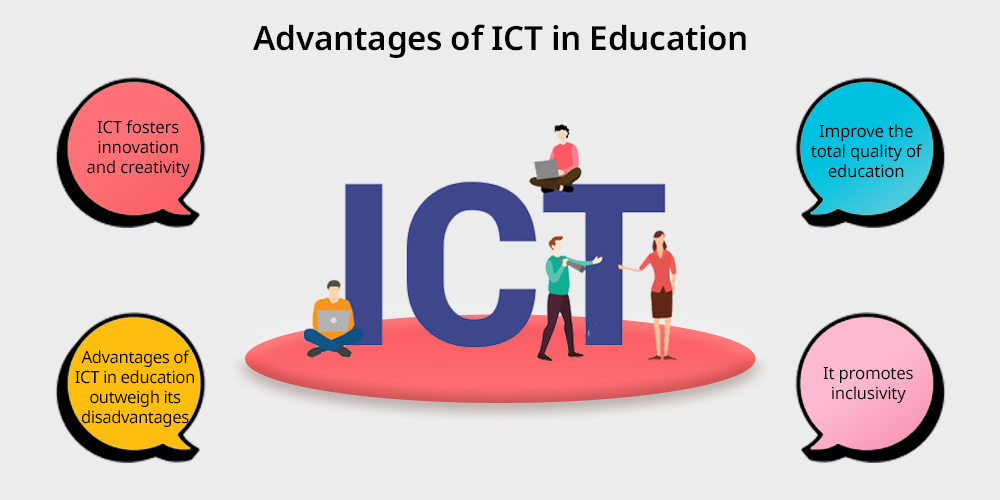
Despite all the challenges ICT has, the advantages of ICT in education outweigh its disadvantages when implemented thoughtfully, especially in cases where inclusivity is something that institutions are promoting.
ICT fosters innovation and creativity in teaching, transforming the classroom experience, contributing to an advanced level of learning sometimes, personalised or sometimes improvised versions of traditional teaching experience but always better, when implemented.
It promotes inclusivity by catering to diverse learning needs and creating opportunities for lifelong learning and don’t you think?
It’s very important to cultivate the culture of acceptance and self awareness in this generation as we grow toward a system that believes in; one size doesn’t fit all.
Therefore emphasising that ICT is not only confined to its application in the learning process.
They shouldn’t be surprised when students are unfit for the digital economy as it provides the necessary training for the industry.
ICT for integrating educational institutions can improve the total quality of education and also the growth of society.
ICT is a useful resource for teachers primarily as a source of information on the educational process, the progress of students, and tendencies in education.
For students, it provides opportunities which simply invite Research, learning and development.
Advantages of ICT in Education and Its Impact
| Advantage | Impact |
| Enhanced Learning Opportunities | Provides access to a vast array of information and resources, enriching the learning experience. |
| Personalised Learning | Tailors education to individual student needs, promoting better understanding and outcomes. |
| Improved Communication | Facilitates interaction between teachers, students, and parents through virtual platforms. |
| Increased Accessibility | Bridges gaps for remote or underserved students and supports those with special needs. |
| Skill Development | Equips students with digital literacy, critical thinking, and problem-solving skills. |
| Efficient Management | Streamlines administrative tasks, saving time and resources for educators and institutions. |
| Global Exposure | Connects students with peers worldwide, fostering cultural awareness and collaboration. |
| Interactive Learning | Engages students with multimedia tools, making learning more dynamic and enjoyable. |
| Cost-Effectiveness | Reduces the need for physical materials, making education more affordable and sustainable. |
| Continuous Professional Development | Keeps educators updated with the latest teaching methods and tools through online resources. |
Conclusion
In the course of development in education, ICT has become a strong support system that changes the way education and communication are delivered.
It has created endless opportunities where students can see more than what is taught in class, and parents can be involved in their children’s learning process like never before.
However, it is crucial to note, before we leap into this technological world that is afoot, that the essence of education is relationships; it is people.
An environment full of laughter, questions, and feelings best described as happiness cannot be created in a classroom with the help of a screen or a gadget. ICT is not here to make this disappear; ICT is here to expand on it.
In this way, with the incorporation of technology into the education system, we can achieve a balance that develops students’ mental as well as spiritual well-being.
Therefore, as we progress forward, walking more and typing less, let us ensure we occasionally lift our heads from our devices, crack a smile, and take a moment to help a fellow human.
After all, learning isn’t a mere data-processing activity but a living process, which makes the future of technology and humanity intertwined.
As students, parents, and educators, we are in the process of cultivating not only tech-savvy individuals but also good-hearted people who think and act for the benefit of making the world a better place.
And this article leaves us with the question………
How does online schooling work? For institutions like 21K School, it is important to understand that we integrate every aspect of technology in education very responsibly and make sure that the learner is well engaged and in the process of learning and shows active participation.

